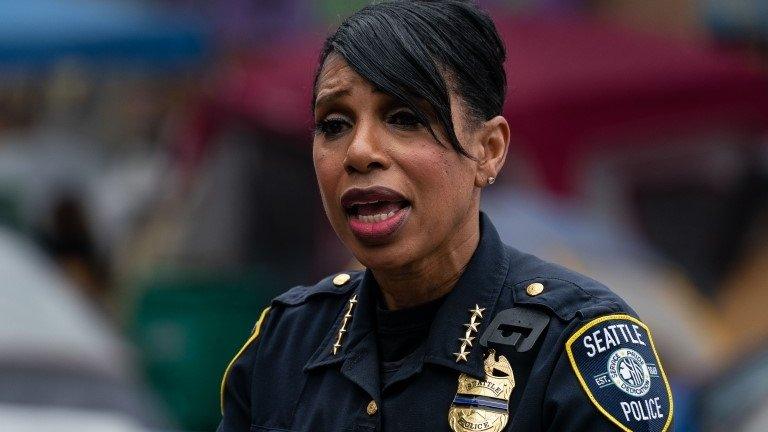This police-free protest zone was dismantled - but was it the end?
- Published
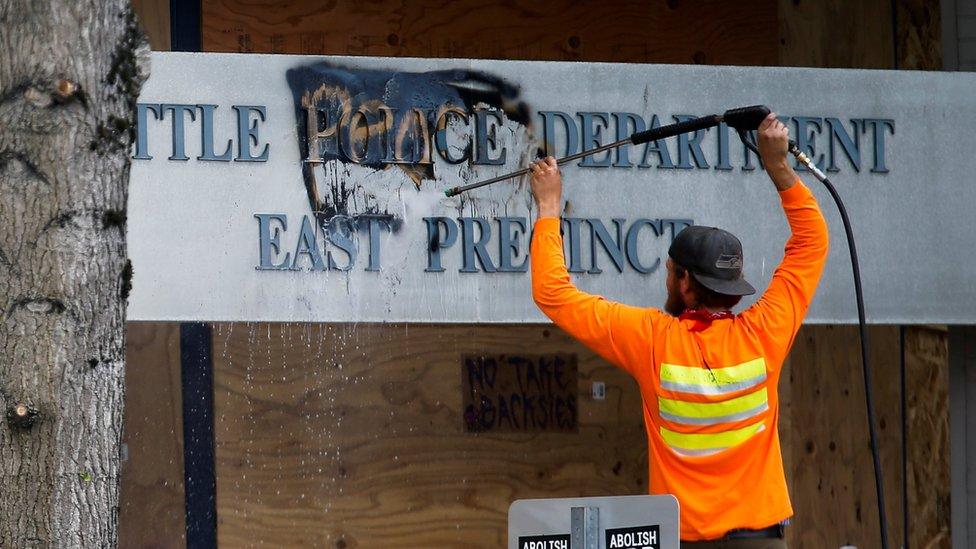
Less than a month after it was set up, Seattle's Chop protest zone was cleared
On 8 June, after a number of increasingly dangerous clashes between protesters and law enforcement, police officers in a popular area of downtown Seattle abandoned their precinct.
Hundreds of activists, who had been demonstrating against police brutality since the killing of George Floyd in Minneapolis in May, then flocked to the neighbourhood and set up a peaceful occupied protest. There, they distributed free food and medical supplies, planted community gardens, and held film screenings and workshops. One small group painted a large, bright statement on a wall within the zone: "Black Lives Matter".
The area was declared the Capitol Hill Autonomous Zone - or Chaz, for short. It was to be a police-free, self-governing utopia. A few days later, in an interview with CNN on 11 June, the city's Democratic mayor Jenny Durkan said the zone could herald a "summer of love".
Protester Grace Morgan, from Portland, Oregon, told the BBC that she travelled up to the Chaz about a week after it had been established.
"It was absolutely astonishing," she said. "There was a food co-op, as well as a full medics corner with actual doctors from around the city that had volunteered, and had their own ambulance. There were classes, lectures, speakers, poetry, lots of live music, huge works of art… It was really beautiful."
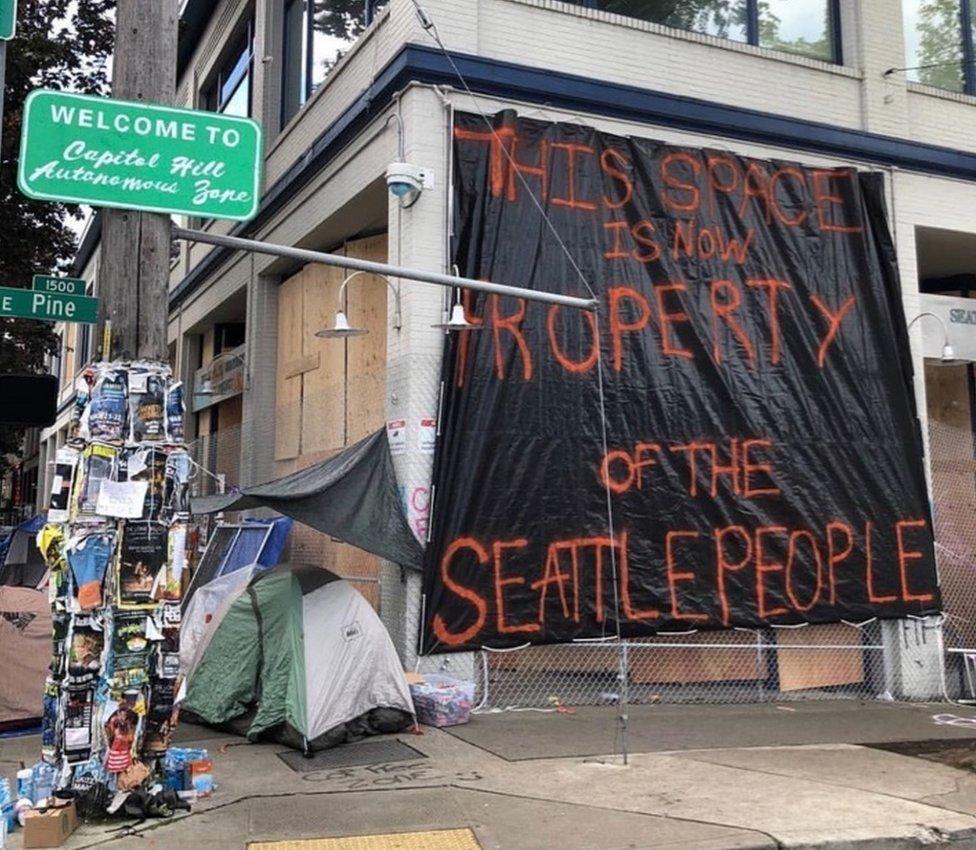
Grace went to the Chaz, as it was then known, about a week after it was established
Crucially, Chaz had the official backing of socialist councilmember Kshama Sawant.
"The idea of occupation isn't a new one, and it's an immensely powerful idea as a part of protest movements," Ms Sawant told the BBC. "Not only social movements on the streets, but also in workplace actions through history."
The initial success of Chaz, which later came to be known as Capitol Hill Occupied Protest (Chop), inspired activists across the US. On 18 June another autonomous zone sprung up in Portland, Oregon. It was declared the Patrick Kimmons Autonomous Zone, or PKAZ, named after a 27-year-old black man who was killed by Portland police in September 2018.
"Sometime around midnight, more tents started to pop up on the street - and then word got around that we were building an autonomous zone right there and then," Grace, who also saw PKAZ get set up, said. "Me and a few of my friends got rolling dumpsters from surrounding businesses and condos in the area, and somebody got a huge couch somehow. There are also quite a few construction sites nearby, so we got a lot of scaffolding from those to help reinforce the borders."
The atmosphere that night, she said, was "pretty magical".
"People were making beats and music just with the things we had around us… and a few spontaneous dance parties broke out," she said. Police officers stayed away for most of the night, which Grace said felt "pretty suspect": "Every other night, the cop presence had been very strong - they had been constantly breaking us up, tear-gassing us, and shooting us with rubber bullets, flash bangs and pepper balls."
But the PKAZ only stood for about five hours. The police arrived at about 05:30, reportedly in full riot gear. "There were about 30 of them and they started dismantling the barriers and telling people to leave," Grace said.
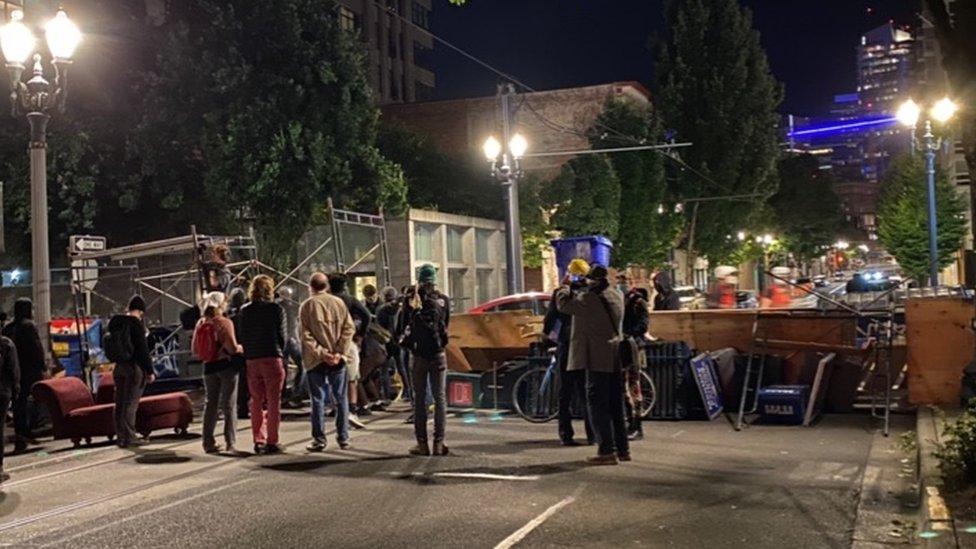
The Patrick Kimmons Autonomous Zone in Portland stood for about five hours
Another autonomous zone, this time on the other side of the country, suffered a similar fate. On 22 June, activists cordoned off an area just north of Lafayette Square in Washington DC. They set up tents and put up signs reading: Black House Autonomous Zone, or Bhaz. The name "Black House" was to place it in contrast to the nearby White House.
By the following morning, Bhaz had been dismantled by the police, and President Donald Trump had vowed in a tweet to meet protesters with "serious force" if they tried to rebuild the area - a threat so serious that Twitter placed a warning flag on it.
And later that week, in Philadelphia, protesters briefly brought a disused hospital back to life. On 27 June a crowd marched to Hahnemann Hospital, set up barricades, canopies, and tables, and nurses began treating patients on the spot. It lasted for less than an hour.
The occupation was led by a coalition of healthcare workers and community members called Care Not Cops, which calls for funding that currently goes to the local police force to be reinvested in preventative public services, such as healthcare and community centres.
Local residents say Hahnemann primarily served low-income and black communities before it was permanently closed by its owner, real estate developer Joel Freedman, in September last year. As the coronavirus started sweeping through the US with force earlier this year, Mr Freedman told local media he had offered to sell the hospital to the city, or lease it for almost $1 million a month - $60 per day per bed, plus utilities and other running costs. The city couldn't afford it, and so despite the growing public health crisis the hospital has remained empty.
Allow X content?
This article contains content provided by X. We ask for your permission before anything is loaded, as they may be using cookies and other technologies. You may want to read X’s cookie policy, external and privacy policy, external before accepting. To view this content choose ‘accept and continue’.

"The hospital shut last summer to immense local resistance, and the owner's attempt at extracting a ransom during the pandemic made it a really potent symbol of privatised health," local reporter Max Fox, who took part in the protest, told the BBC. "So there was a lot of pent up anger."
At the time of his offer, a spokesman for Mr Freedman told US media that he had offered to sell the hospital to the city below market rates, and that he had "not only desired to be helpful to the city… but he was very reasonable".
Although brief, the Hahnemann Hospital occupation touched on a crisis that has run parallel to these protests - access to healthcare, particularly as the US has the world's highest number of coronavirus infections and the highest death toll.
Patrick Cline heads up an organisation called the Frontliners, which distributes medical supplies to protesters across the US through a network across different parts of the country, including Seattle. He told the BBC he started the organisation after seeing a police officer destroy medical supplies at a protest.
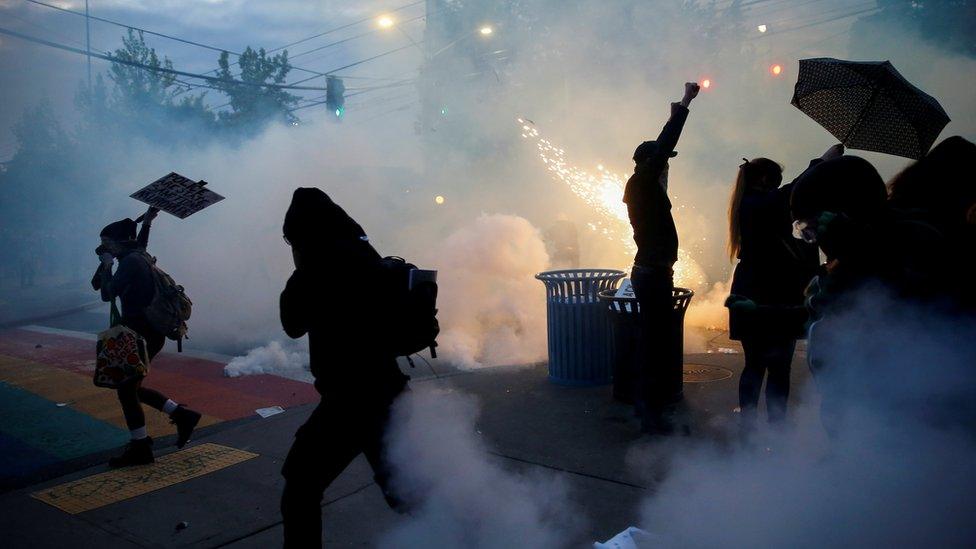
Before leaving the precinct in early June, Seattle police deployed tear gas and flashbang grenades against protesters
"He took his elbow and put it through a medic table - and all of the food and medical supplies spilled out onto the ground, and he stomped with his foot on the medical supplies," he said. Later, he saw videos of other officers doing the same thing in other parts of the country. "[Medics] weren't there to burn down buildings and whatnot, they were just there to help others being injured."
Councilmember Sawant accused the police in Seattle of targeting medics, too.
"Early on in the Capitol Hill movement, when the protest movement was facing down police violence, it was not only that the police were targeting peaceful protesters with mace and tear gas - they were targeting the medic tents near the protest action," she told the BBC. "I can tell you from personal experience how horrific it is. I was personally among the hundreds who were there. We were tear gassed and maced, and the number of flashbang grenades that were exploded… it looked like a war zone."
Then, there were the shootings.
There were four shootings at the Chop in a 10-day period towards the end of June, two of which were fatal. The first shooting happened in the early hours of 20 June, killing 19-year-old Horace Lorenzo Anderson and injuring a 33-year-old man. A second shooting the next day left a 17-year-old boy injured, and another person was wounded in a third shooting two days later. In the fourth shooting, on 29 June, a 16-year-old boy was shot and a 14-year-old boy was left critically injured. Allegations of sexual assault and mental health crises within the zone began to be reported, too.
Although protesters insisted the violence wasn't directly connected to Chop, the atmosphere in the community began to change.
Some officials who had previously been supportive of the protest zone began to sour, too. Mayor Durkan walked back her "summer of love" comments, and at the end of June announced that the zone would be dismantled, claiming the movement's message had "been undermined by violence". On 1 July, Chop reached a violent end.
The Seattle Police Department tweeted that anyone who remained in the area, or returned to it, would be arrested. After the area was cleared, Police Chief Carmen Best tried to put a nail in the idea of a police-free society, telling reporters: "Enough is enough."
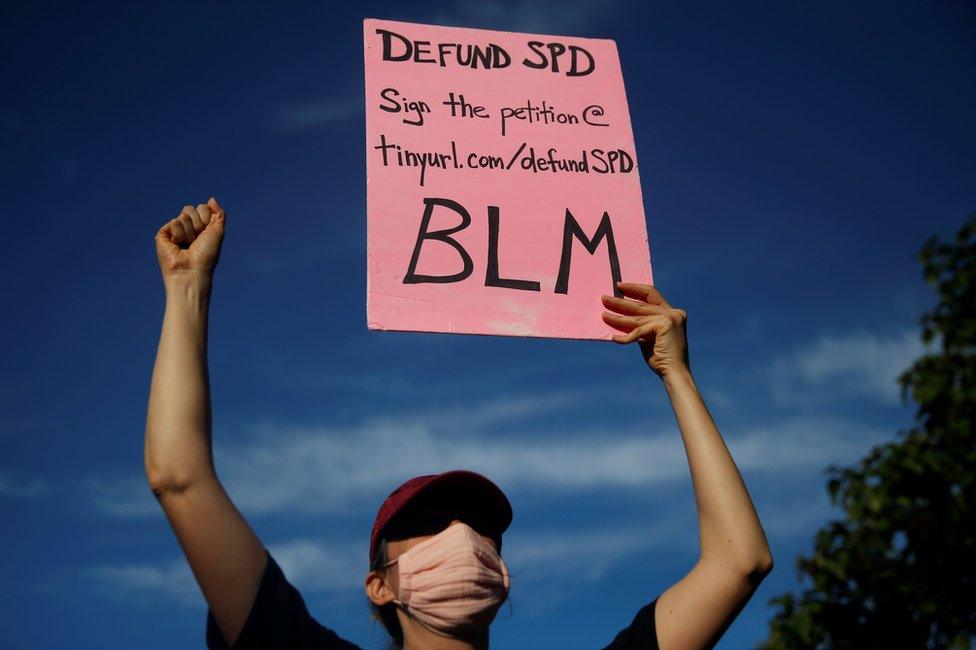
Daniel Baryon, an anarchist YouTuber from Tulsa who spent a week in Chop towards the end of its existence, said the zone felt like it was on its "last legs" - and in contrast to the hopeful atmosphere when it was first established, negative coverage, a lack of democratic process and a toxic atmosphere all contributed to protesters feeling a "lack of enthusiasm" towards the end.
But the movement is looking to the future, he told the BBC.
"People are trying a tactic and seeing how it works, what the successes and the failures are, and how they should move forward," he said. "I don't want to get too specific, but the direction many people are going in is towards organising neighbourhoods, democratic structures that allow people to make decisions together, and to create an autonomous zone but the other way around - by building citizen power first, and then declaring autonomy, instead of seizing an autonomous zone in a spontaneous moment and then having to work through the chaos."
This democracy, he adds, would be "a consensus process - it's not electing representatives to decide for you, but it's everybody sitting down, forming the path forward together through discussion, and voting as a direct democracy".
For Grace, the autonomous zone was never meant to last forever. "I think it's sad and symbolic, and the way the police dismantled it was really terrible," she said. "But I don't think it was meant to be a permanent thing... it was meant to be a moment in time, a piece de resistance - and in that way it served its purpose."
- Published2 July 2020
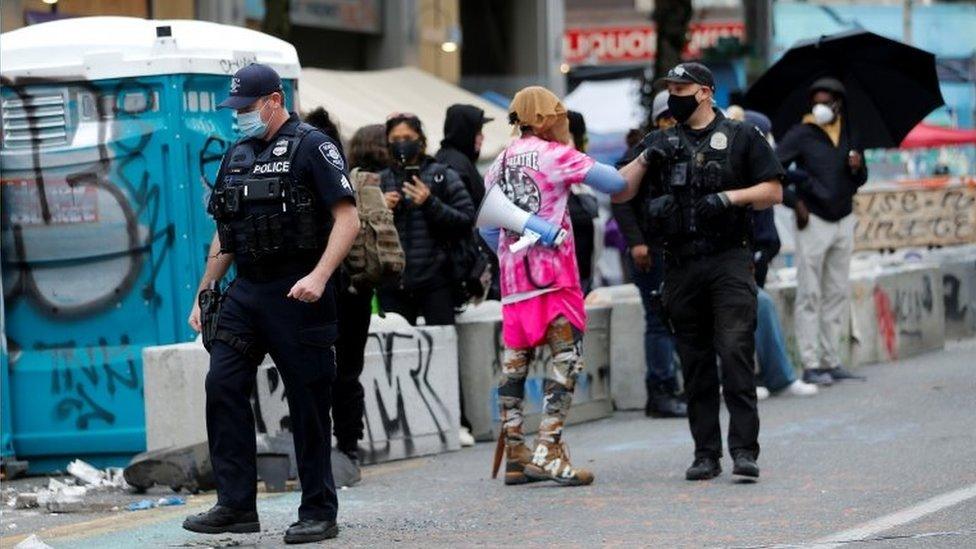
- Published23 June 2020
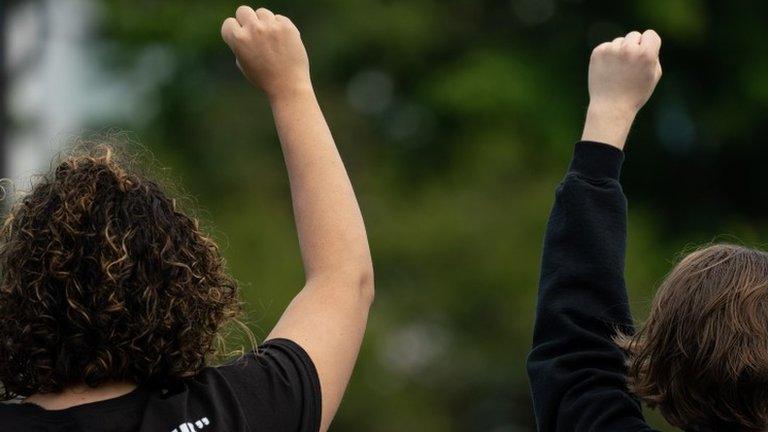
- Published30 June 2020
